Ancient castles perched on rocky islands, mist-wrapped mountains rising from lochs, and single-track roads that wind through breathtaking scenery. Our Scottish Highlands road trip itinerary covers it all.
By: Paul Healy | Last Updated: | Jump to Comments
We spent four unforgettable days exploring the legendary Scottish Highlands. Starting and ending in Inverness, this itinerary weaves together iconic film locations, world-renowned whisky distilleries, and landscapes so dramatic you’ll think you’ve stumbled into Middle-earth.
This isn’t a tick-box tour. With just three to four hours of driving each day, you’ll have plenty of time to stop, stare, and soak in the majesty around you.
We explored the otherworldly rock formations of the Quiraing, drove the most dramatic mountain pass in the UK, stood before Scotland’s most photographed castle, and discovered beautiful valleys.
We stayed in charming villages away from the crowds, where cosy pubs with crackling fires and award-winning restaurants await at day’s end.
Our itinerary covers all the information you need for a great road trip, including a map with all the locations marked, tips on where to eat and where to stay, and alternative things to do based on how much time you have each day.
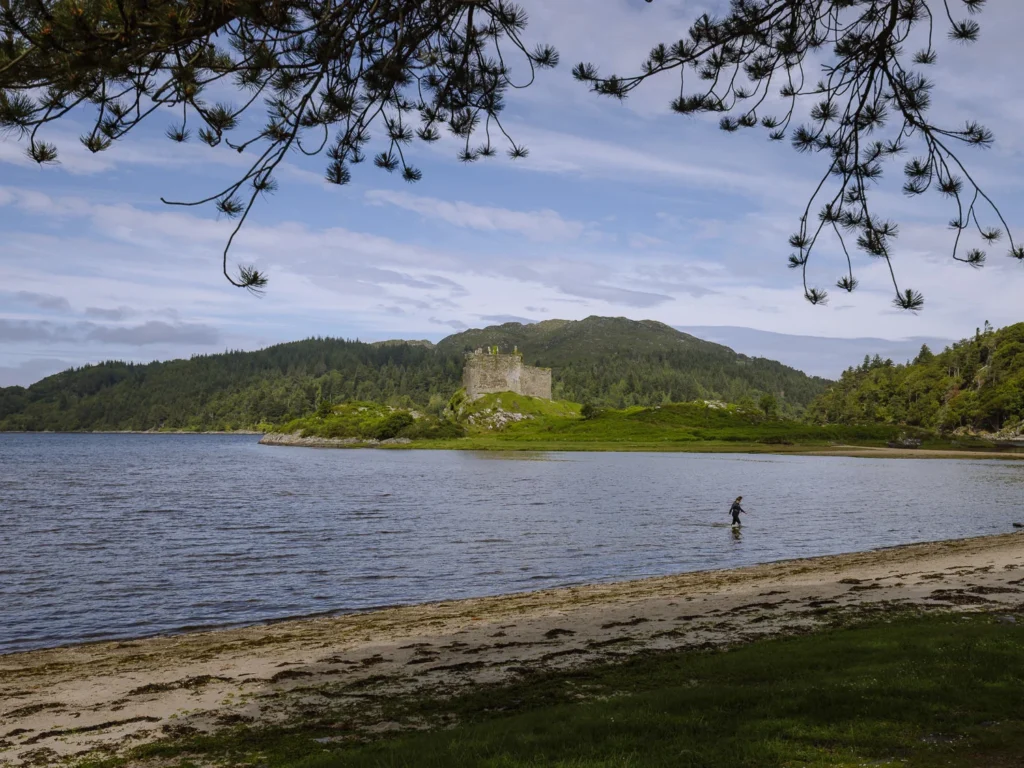
ROAD TRIP OVERVIEW
We have constructed this itinerary to capture the best of the Scottish Highlands. It begins and ends in Inverness and visits two iconic castles, a renowned whisky distillery, the most dramatic landscapes, several picturesque villages and some great local pubs.
Each day involves three to four hours of driving, allowing plenty of time to stare out of the car window at the stunning Scottish scenery, enjoy a few short walks, and stop at the major attractions.
We spend the evenings in lovely towns or villages, away from most of the crowds, and with easy access to an atmospheric pub or great restaurant.
Here is a day-by-day breakdown.
- Day 1 – Inverness, Torridon, Bealach na Bà, Eilean Donan Castle & Plockton
- Day 2 – Isle of Skye including Old Man of Storr, The Quiraing, & Talisker Distillery
- Day 3 – Glenfinnan, Ben Nevis, Kilchurn Castle & Inveraray
- Day 4 – Glencoe, Loch Ness, Urquhart Castle, and Inverness
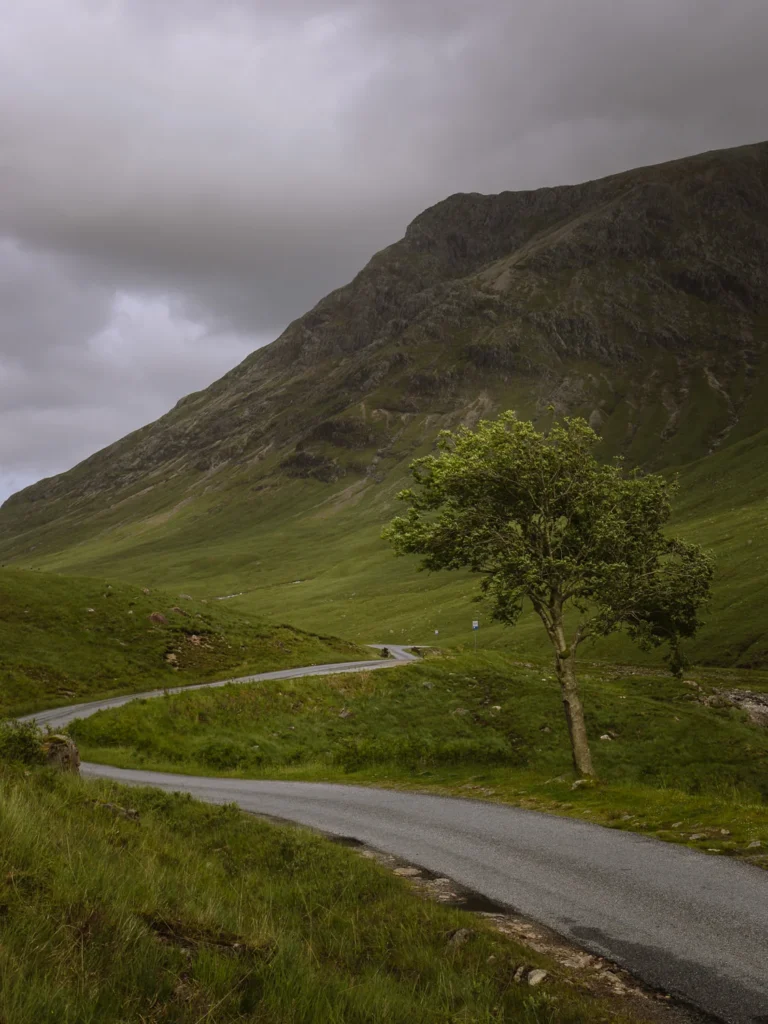
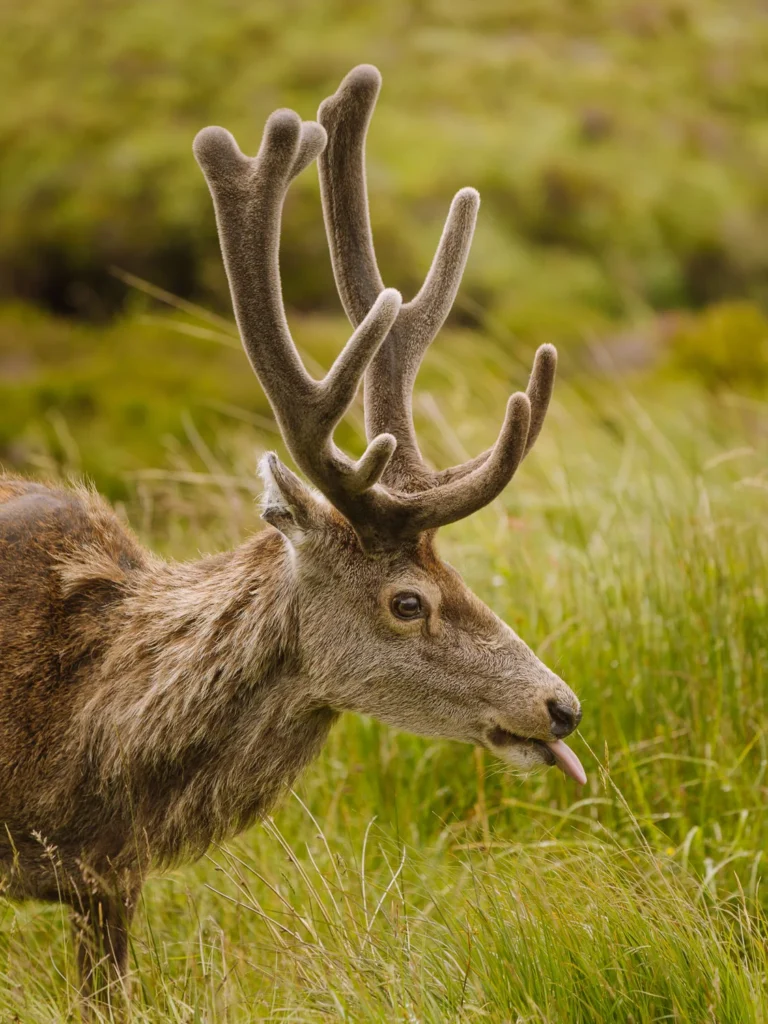
ROAD TRIP MAP
Below is the map of the route we took, including major attractions, cafes, and places to stay.
Day 1 activities are in red, day 2 in orange, day 3 in purple and day 4 in brown.
Hotels for each night are marked in black.
USING OUR MAPS. Click on the top right corner to open in the Google Maps app. Click on the star to save to your Google account.
4-DAY SCOTTISH HIGHLANDS ITINERARY
ARRIVE IN INVERNESS
This itinerary begins in the city of Inverness, the best-located city for exploring the Scottish Highlands. The airport is situated on the outskirts of town, and several major car rental companies have a presence at the terminal.
If you arrive early in the day, spend a couple of hours exploring the centre of town, including the castle and museum.
Alternatively, visit the Culloden Battlefield, where the Jacobites were defeated by the British Army in a fierce one-hour battle, marking the end of the Scottish Stuarts’ dreams of reclaiming the British throne.
STAY
Instead of spending the night in Inverness, we stayed at Loch Ness Country House Hotel in the surrounding countryside. It’s a lovely country home with log fires and old-world charm.
As an alternative, Bunchrew House Hotel is a grand old estate on the edge of Beauly Firth. It has traditionally styled rooms with great communal areas and lovely grounds to explore.
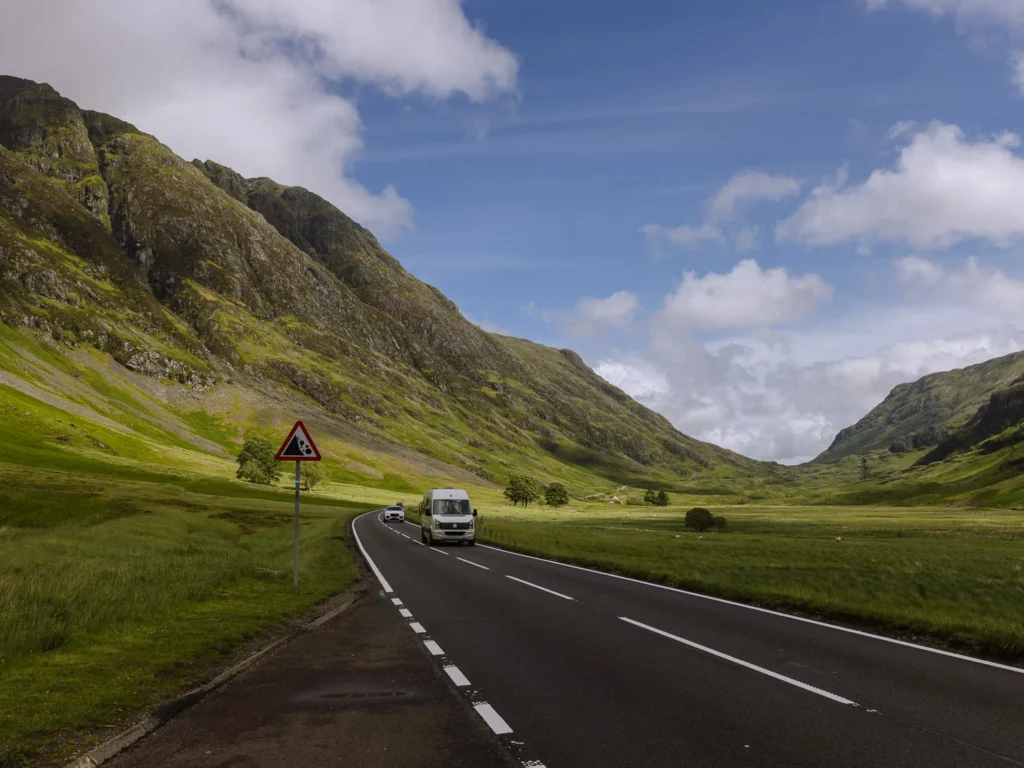
DAY 1: INVERNESS TO PLOCKTON
- Driving Time: 4 hours
- Distance: 142 miles
We love getting into the wilder sections of the Scottish Highlands, and the first day of this itinerary does just that. Over the course of 142 miles, we passed some of the most rugged mountains in Scotland, crossed the most dramatic high pass in the UK, and stopped at the most photographed castle in the Highlands.
MORNING
We left Inverness and headed towards Achnasheen (A835 and then A832). After about 30 minutes, the hills give way to mountains, and the lowlands are replaced by high and wild scenery.
After an hour, we stopped at the Midge and Bite Café for a coffee and a recharge.
Shortly after leaving Achnasheen, we stopped at the Glen Docherty Viewpoint for views down to Loch Maree. At Kinlochewe, we turned left and followed the A896 into the heart of Torridon.
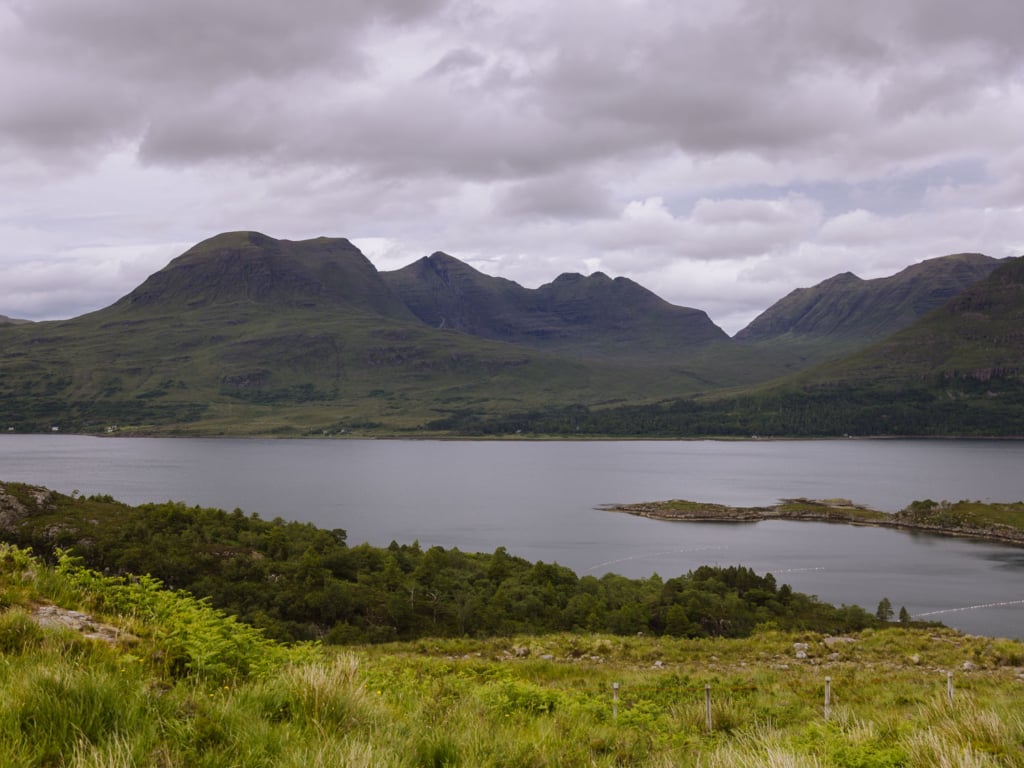
The part of Scotland we drove through today has some of the most rugged and wild scenery. The horizontal stratification of Torridonian Sandstone gives the mountains a striking shape and reddish hue.
There are many places to stop by the side of the road. Be sure to keep an eye out for red deer or golden eagles. A very friendly stag came right up to check us out while we were looking around.
The road drops down to the village of Torridon. There are a couple of cafes, including the pretty Wee Whistle Stop Café, with outdoor benches looking over the loch.
The road now follows the southern edge of the loch, with great views to the mountains opposite. We took a detour off the main road to the village of Shieldaig, a quiet place prettily perched on the edge of the loch.
After leaving Shieldaig, take the minor road on your left that follows the west coast to Applecross. We loved this stretch of road. It may be narrow in places, but it’s lots of fun as it twists and turns through little villages.
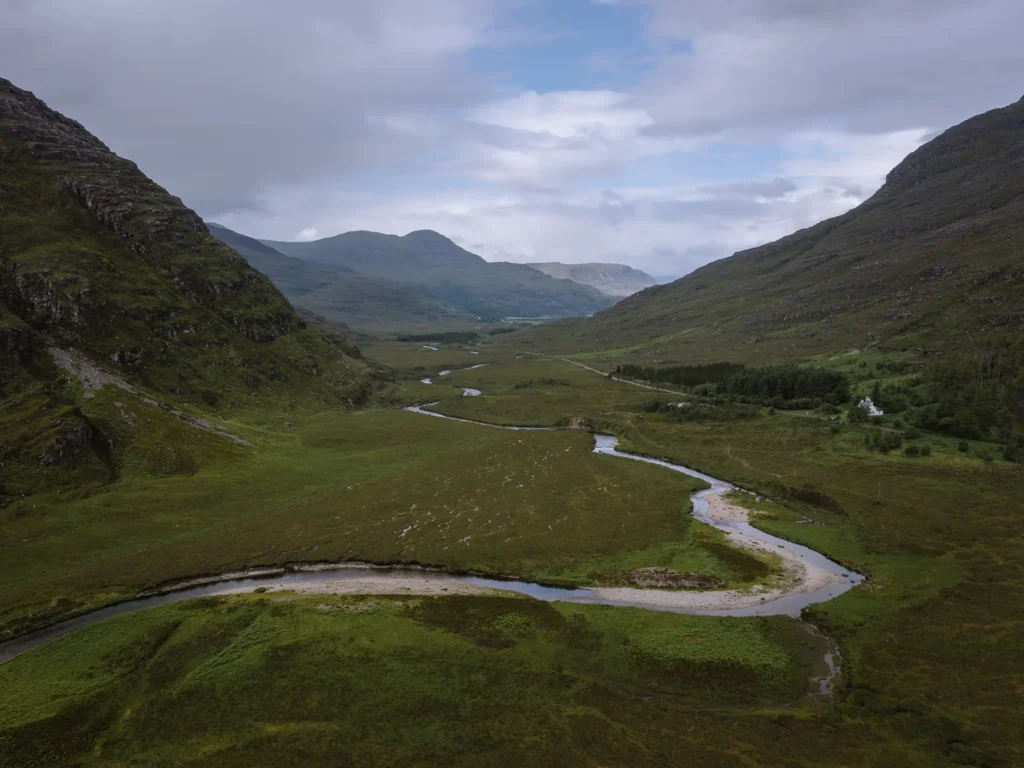
LUNCH
There are a couple of great options for lunch.
Shieldaig Bar & Coastal Kitchen is a smart bistro serving fresh seafood overlooking the loch in Shieldaig.
The Inn in Applecross serves tasty pub grub, but there are also numerous shacks on the seafront serving the many bikers on the NC 500. It’s a fun and good-value place to take in the hubbub.
AFTERNOON
After lunch, we took the road that goes from Applecross up to Bealach na Bà and back down the other side.
After many years of road tripping across the UK, this is possibly the most dramatic road in the UK. The single-track lane twists and turns up steep gradients and around tight hairpins, rising to 626 metres.
Next, we went to Eilean Donan Castle. One of Scotland’s most photographed castles, it sits on a small tidal island and is surrounded by imposing mountains. The best photos can be taken from the gravel beach on Eilean Thioram.
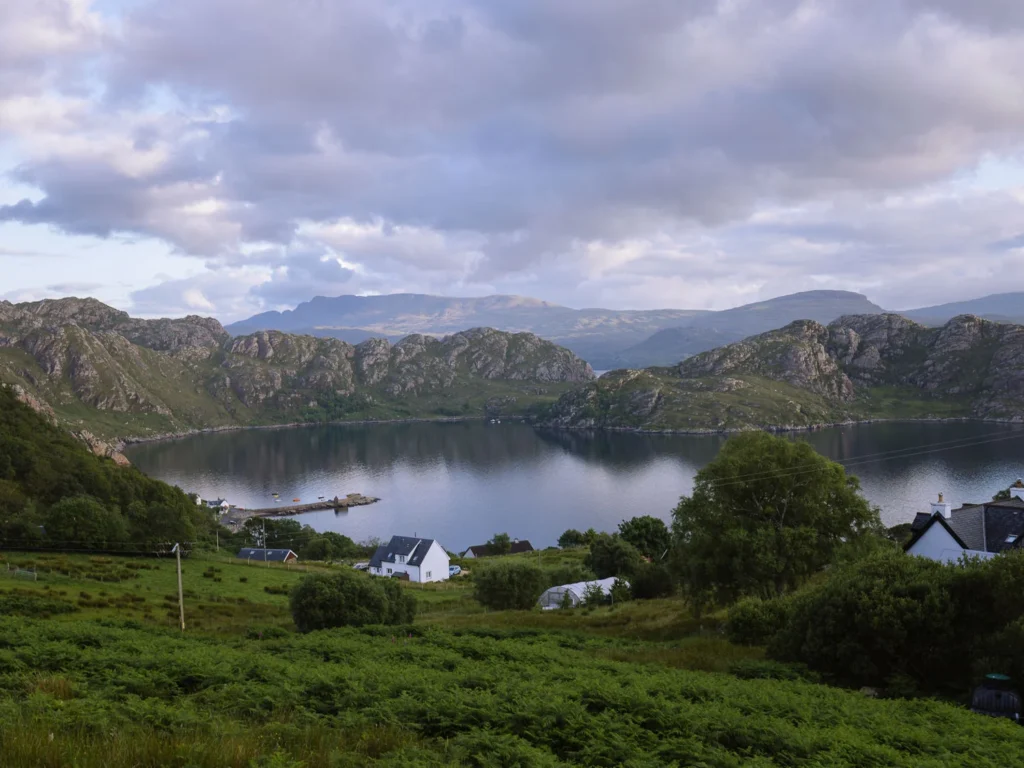
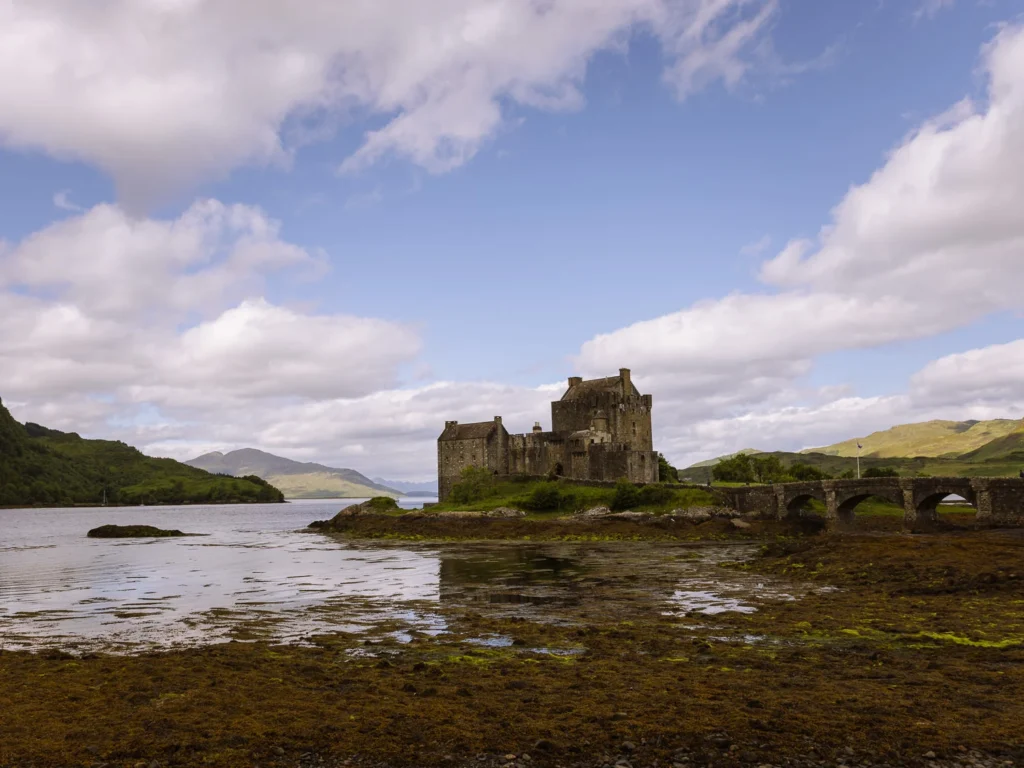
STAY
End the day in Plockton. This little fishing village on the shores of Loch Carron is one of the prettiest in the UK and was used as a filming location in Hamish Macbeth. Its special microclimate allows palms and other unusual plants to survive. The village is most beautiful at high tide when the mountains are reflected in the water.
We stayed in The Plockton Hotel which has an award-winning bar in an ideal location on the waterfront.
Alternatively, the Plockton Inn is a charming historic hotel spread across three different buildings serving high-quality food.
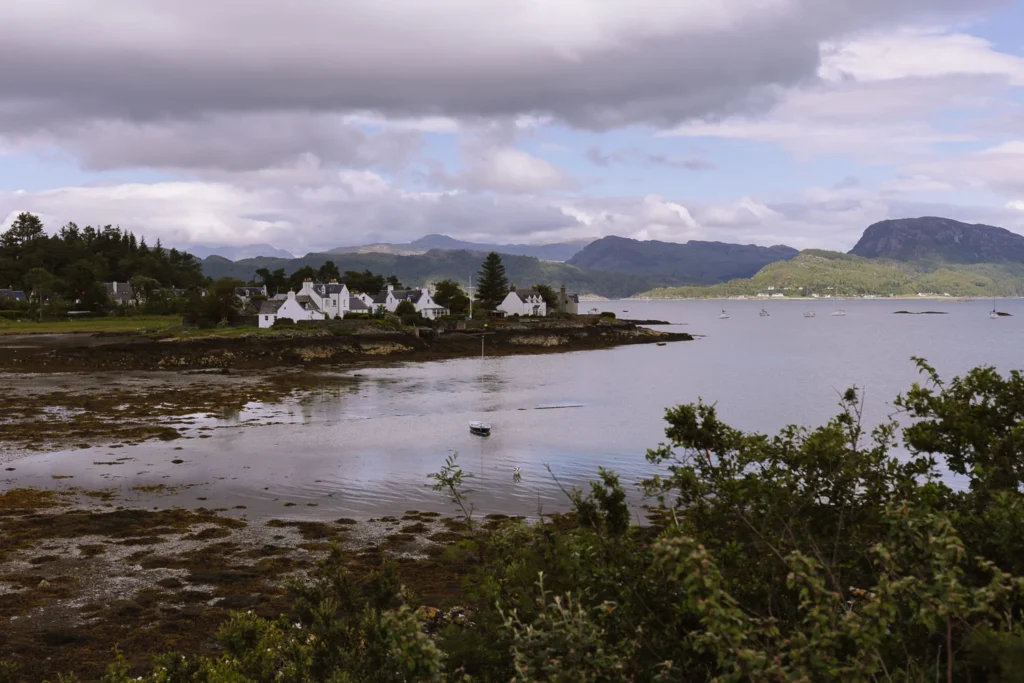
DAY 2: PLOCKTON TO ISLEORNSAY
- Driving Time: 4 hours
- Distance: 135 miles
Today we explored the Isle of Skye, which has some of the most interesting and varied scenery in the UK. You can read more about what to do on our guide to the Isle of Skye.
You won’t have time for all of them, so we suggest you pick the things that interest you most.
MORNING
This morning, we left Plockton and headed over the Kyle of Lochalsh to the Isle of Skye.
We passed through Broadford and Portree on the way to the Trotternish Peninsula. The peninsula is marked by a series of landslides that have created wild and strangely shaped landscapes.
There are several to explore as you drive around the peninsula:
Old Man of Storr – A dramatic pinnacle that stands apart from the main ridge. There are stunning views over Loch Leathan, but to capture the most iconic photos, you need to undertake the Old Man of Storr Walk (about two hours).
Kilt Rock and Mealt Falls – A beautiful waterfall that plunges over basalt rock columns into the ocean below. It’s right next to the car park.
The Quiraing – A large landslip, still moving today, that has left behind all sorts of strange shapes in the rock, including the Needle, the Prison and the Table. The best views are just a 30-minute walk from the car park, but you could also opt for this excellent Quiraing 2-hour circular walk.
Fairy Glen – An area of natural rock formations featuring small cone-shaped hills and grass-framed ponds. It possesses a strange, whimsical, almost fairytale-like appearance. Exploring it takes about 45 minutes to an hour, but parking can be tricky.
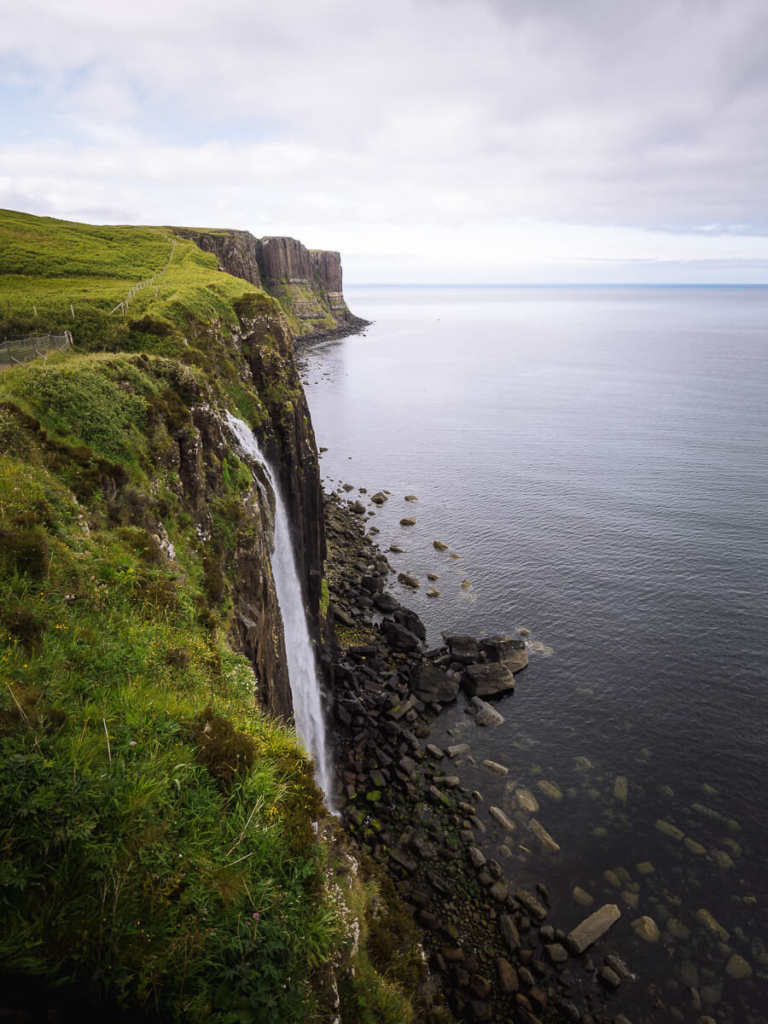
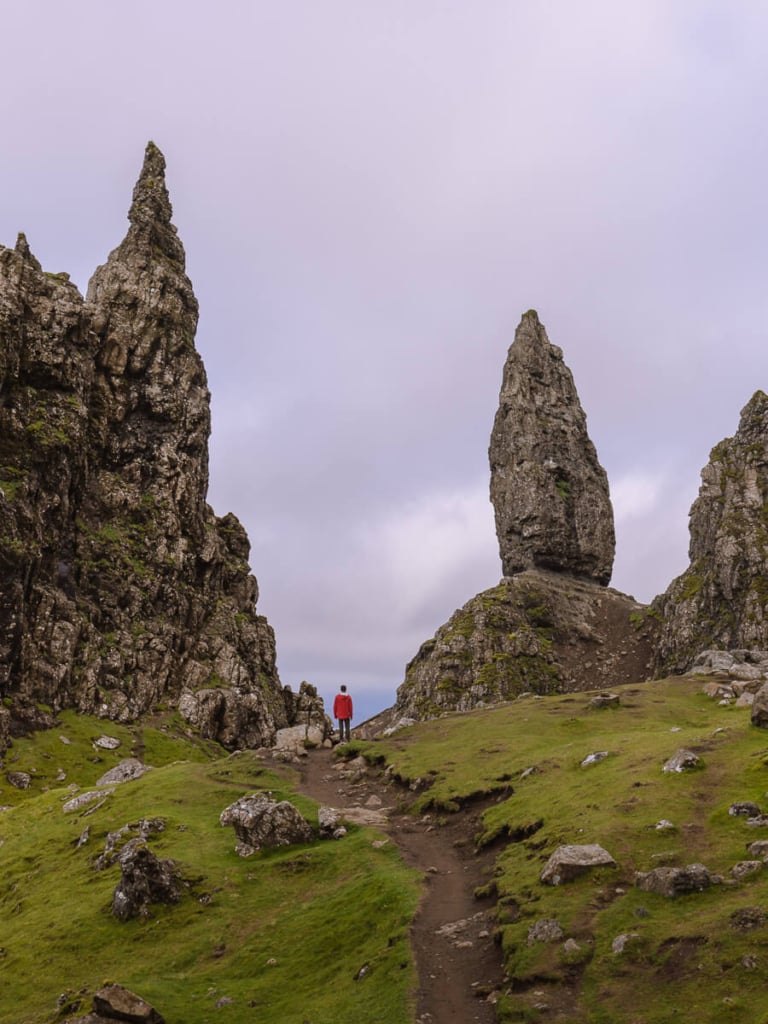
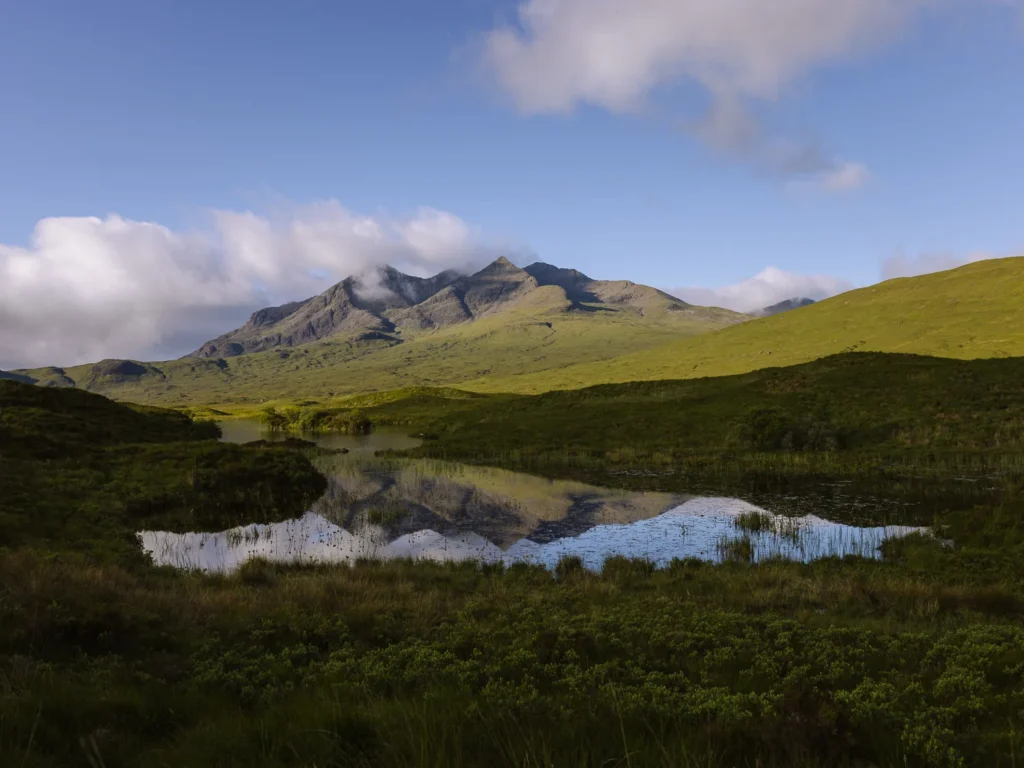
LUNCH
We had lunch in Portree after checking out the colourful houses and taking a quick stroll around some of the streets.
The Birch Café has good coffee with a selection of sandwiches and baked goods. Café Arriba serves breakfast all day and has a great range of vegetarian soups, flatbreads and daily specials.
AFTERNOON
In the afternoon, we explored the southern part of Skye.
Our first stop was the Talisker Distillery. This premium single malt has been distilled in Carbost on the Isle of Skye since 1831. Book online in advance.
Depending on how long you spend at the distillery, you may have time to visit the Fairy Pools. At the foot of the Black Cuillins near Glenbrittle, these crystal-clear rock pools are connected by a series of cascades in the Allt Coir’ a’ Mhadaidh brook.
On a warm day, it’s a great (but very cold) spot for a dip. Even if that doesn’t appeal, the views up to the Black Cuillins are excellent. It takes about an hour to explore them from the car park.
Finally, as you make your way to Isleornsay, stop at the Sligachan Hotel. The nearby bridge offers excellent photo opportunities over the river to the Black Cuillin — the most rugged, craggy and dramatic mountains in the UK.
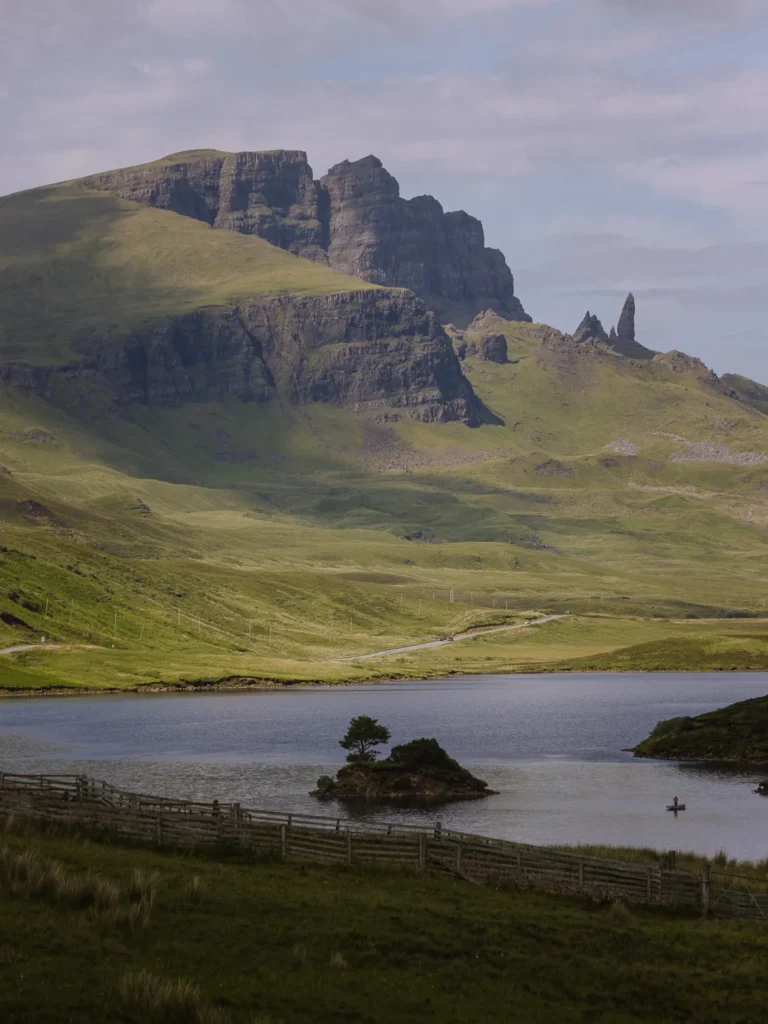
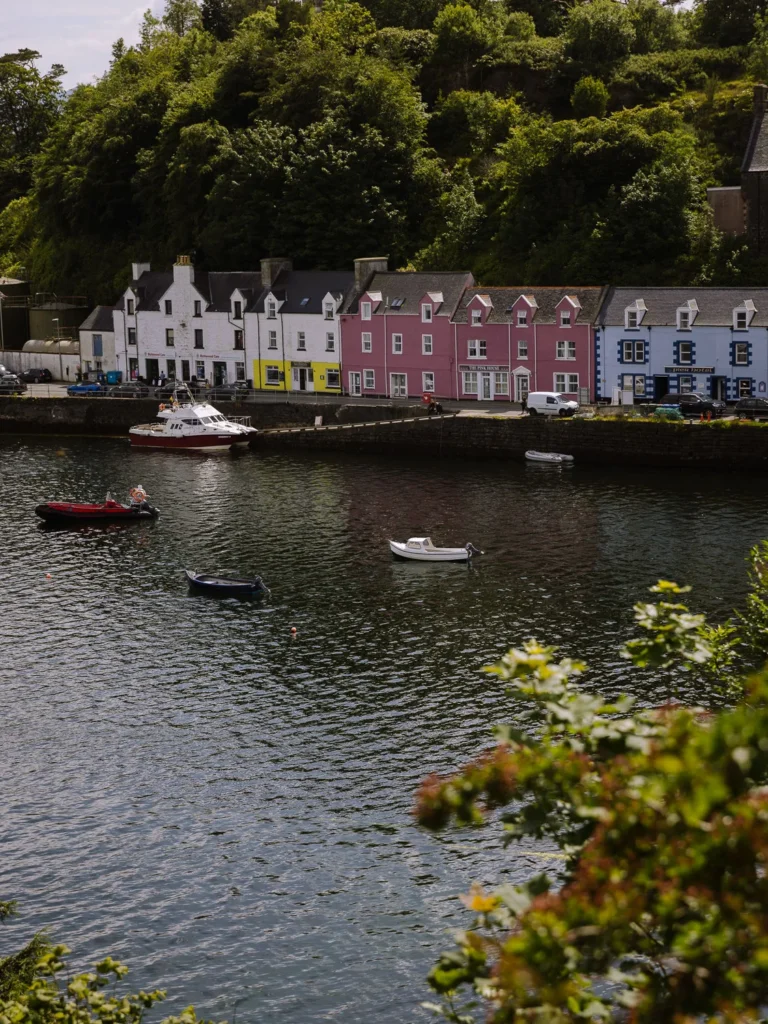
STAY
We love staying at the Hotel Eilean Iarmain in Isleornsay. The tiny village of whitewashed houses on the east coast of Skye is pretty enough, but the main attraction is the hotel itself. In the evening, its log fire and candlelit dining room is a refined spot to treat yourself to a locally sourced dinner.
The attached Bar Am Pràban pub is a cosy wood-panelled inn with more whisky brands than you could possibly drink.
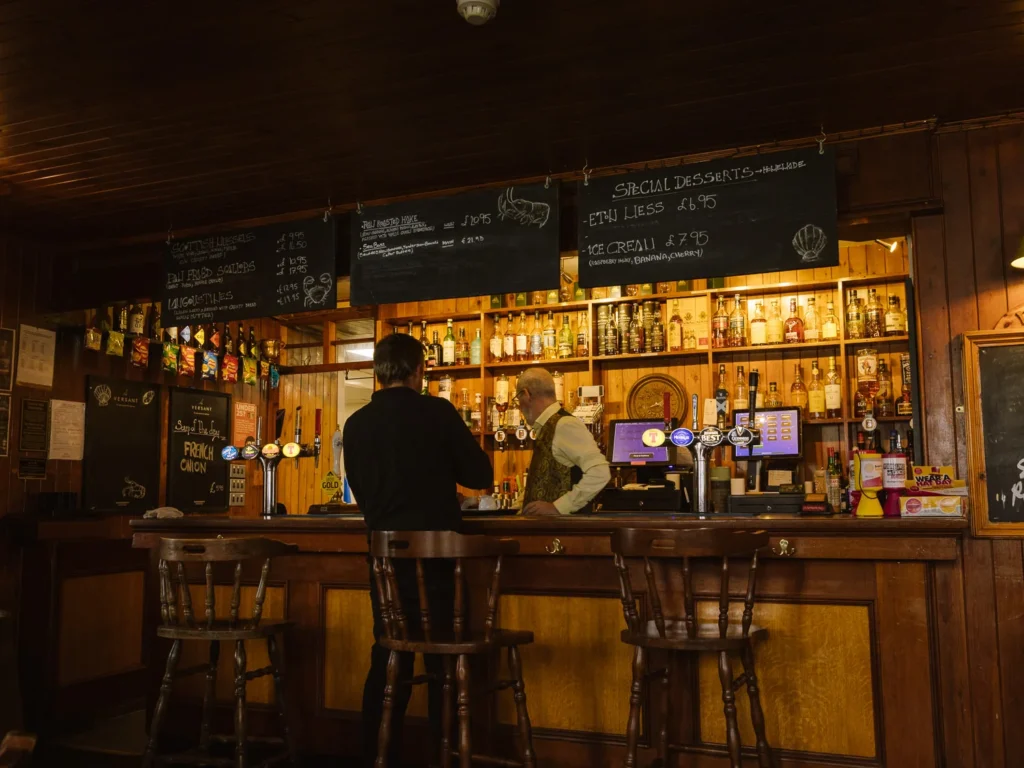
DAY 3: ISLEORNSAY TO INVERARAY
- Driving Time: 3 hours driving, 30-45 minutes ferry
- Distance: 120 miles
Today is full of highlights. It starts with a great ferry ride, then visits the most photographed viaduct in the country before heading across the Arisaig peninsula for views of Ben Nevis.
Finally, it stops at one of the moodiest castles in Scotland before ending at a picture-perfect town perched at the end of Loch Fyne.
MORNING
We caught the early morning ferry from Armadale to Mallaig (30-45 minutes). During peak season, be sure to book in advance.
From Mallaig, we drove through the stunning Arisaig peninsula towards Glenfinnan Viaduct. Keep an eye out for the white sand beaches on your right.
If the weather is good, you could head down to one of them and go for a dip. We recommend the Silversands of Morar or Camusdarach Beach.
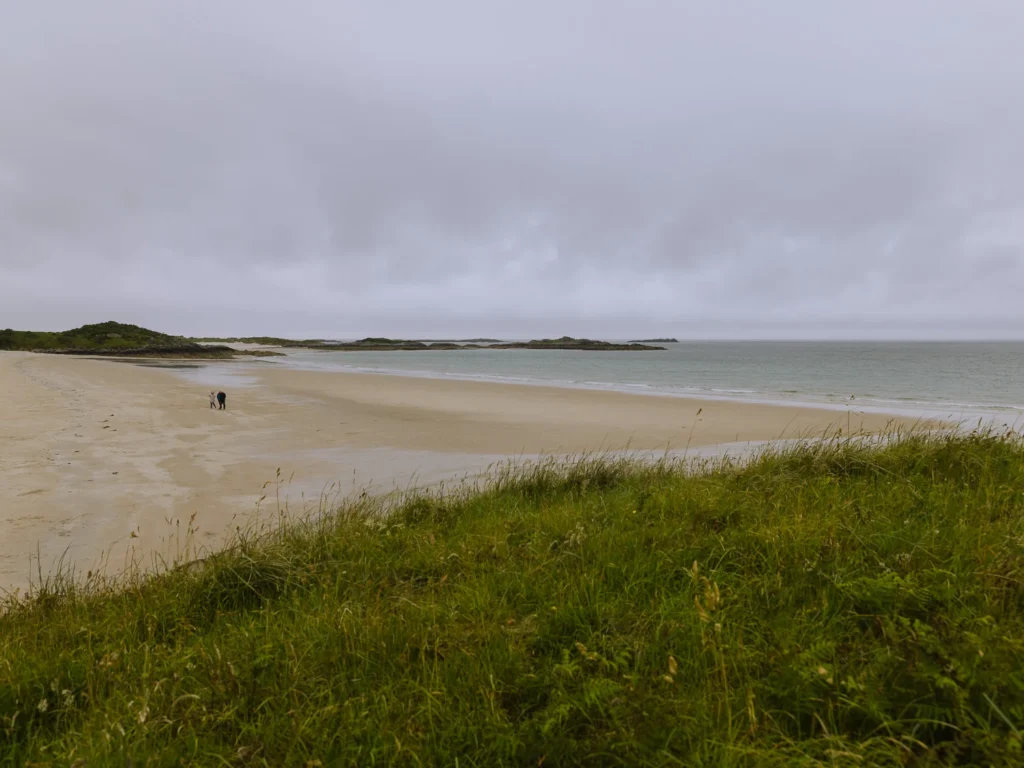
Next stop is the Glenfinnan Viaduct and Monument. The viaduct has become increasingly popular due to its appearance in the Harry Potter films, and the Jacobite steam train still crosses it daily in the summer.
Getting a photo as the train passes takes a bit of planning. The best viewpoint is from the hillside on the left of the bridge as you face it from the car park. The walk to the viewpoint takes ten minutes.
The train passes about 30 minutes after it leaves Fort William heading westwards, or 30 minutes before it arrives in Fort William heading eastwards. Check the latest timetable in advance.
Nearby, the Glenfinnan Monument has wonderful views over Loch Shiel. The visitor centre tells the story of Bonnie Prince Charlie in the place where the Jacobite uprising began. It’s an informative and pretty stop.
The drive now heads along the edge of Loch Eil. As you approach the end of the loch, great views of Ben Nevis appear above the water. The excellent viewpoint at Corpach (marked on the map) is well worth a stop.
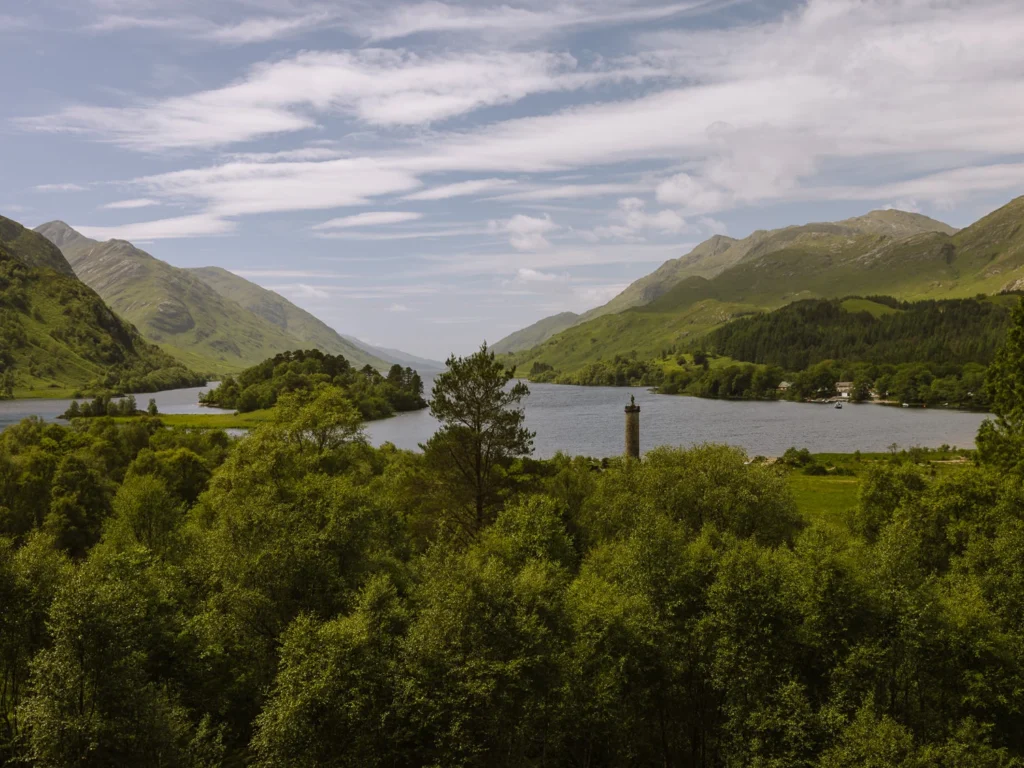
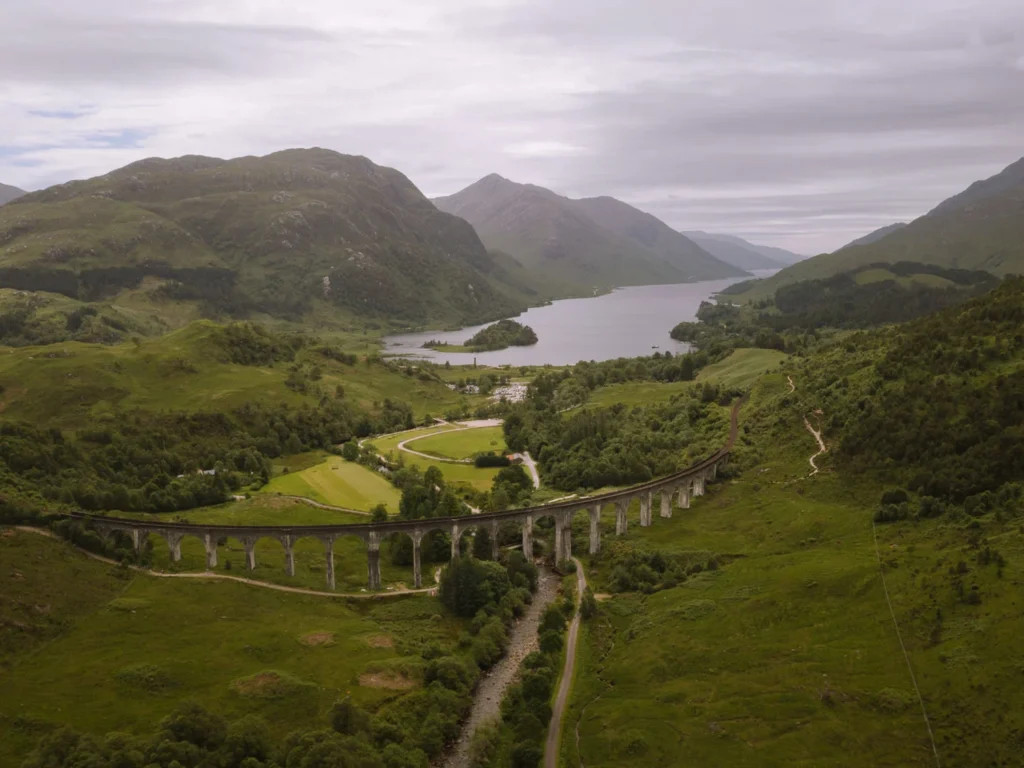
LUNCH
An easy and pretty place for lunch is An Cafaidh Mara Corpach. The café is situated right next to the Corpach Viewpoint, offering great views across the loch. There are also cafes at both the Glenfinnan Viaduct and the Glenfinnan Monument.
Another option is to head into Fort William. It is not our favourite Scottish town, but it is the centre of the Scottish Highlands, and the High Street has a wide range of places for lunch.
The Wildcat has a good selection of vegan dishes, The Geographer is a bistro in a homely setting, and the Kilted Camel has decent coffee and even better cakes.
AFTERNOON
In the afternoon, we drove south along the eastern side of Loch Linnhe towards Castle Stalker. This tiny castle is perched on an island just off the mainland. We think the best view is from the jetty at Loch Laich, which is just a short walk behind the Old Inn on the A828 in Appin.
Next, we followed the A828 and then the A85 to Kilchurn Castle. Set deep on the edge of Loch Awe and surrounded by towering mountains, it is our favourite castle in Scotland. The high crags often shelter the lake from wind, and wonderful reflections of the castle can often be seen in the water.
There are a couple of excellent viewpoints. The first is along a spit of land as you walk towards the castle, the second is from a layby on the other side of the lake. We have marked both on the map above.
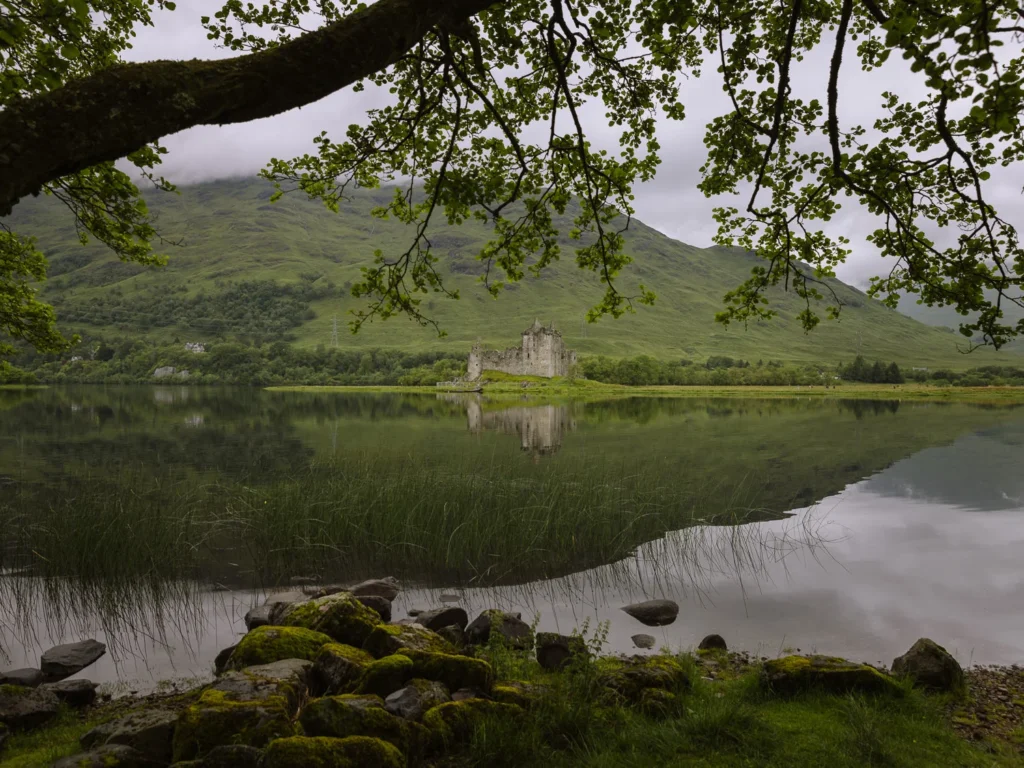
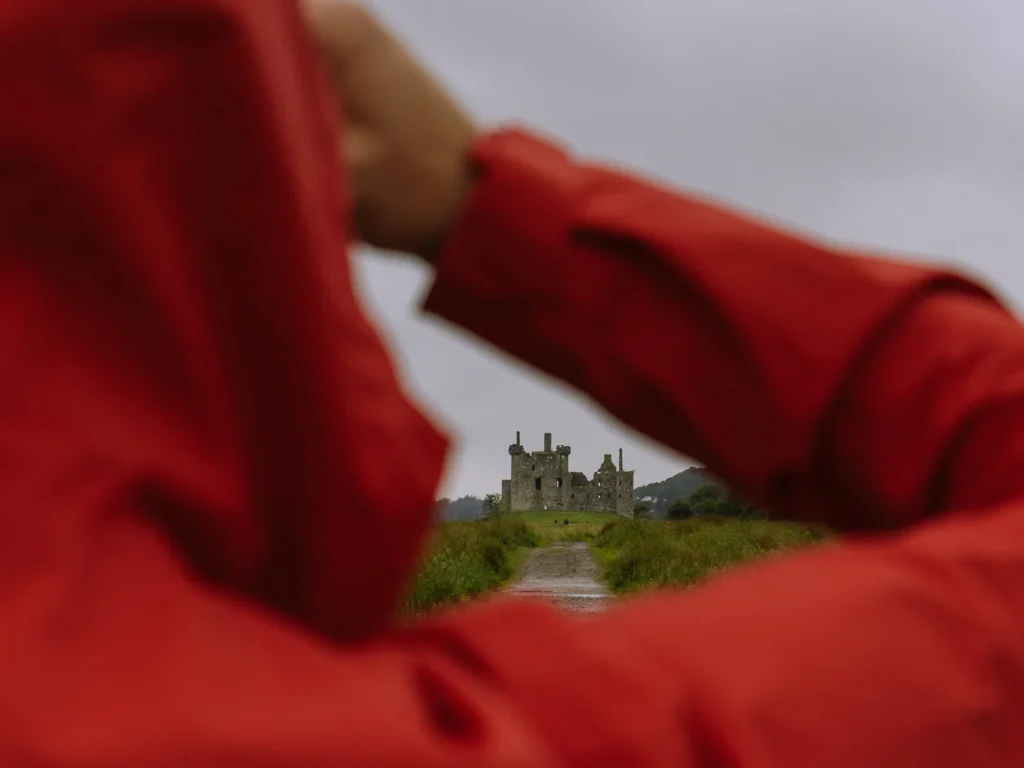
STAY
End the day in Inveraray. This lovely, whitewashed town sits proudly at the edge of Loch Fyne. Its Georgian architecture conveys a regal grandeur, and the high street is an excellent blend of grand hotels, cosy cafes, and charming shops. It can be overrun during the day, but we think it’s a great place to spend the evening.
The George is a historic coaching inn featuring modern, stylish rooms that retain its old-world charm. The bar hosts live music and has an extensive selection of whiskies.
Brambles of Inveraray is the premier address in town. Situated in the middle of the High Street, it has gorgeous, classically decorated rooms and serves a full Scottish cooked breakfast.
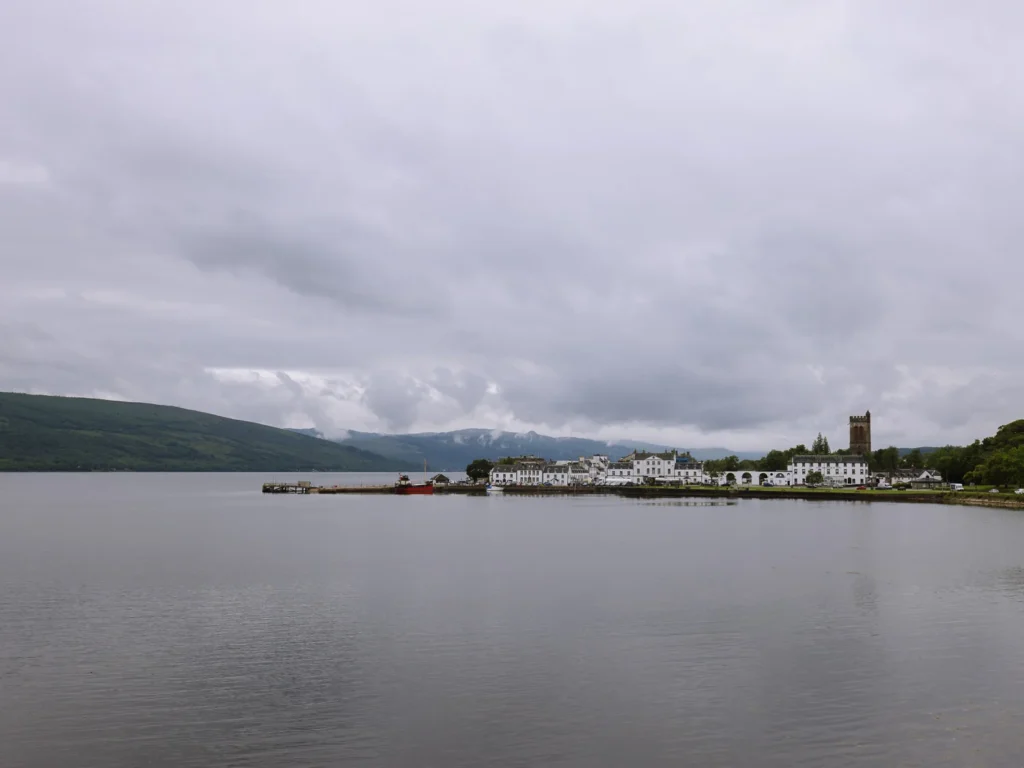
DAY 4: INVERARAY TO INVERNESS
- Driving Time: 3 hours 30 minutes
- Distance: 140 miles
Today we explored Glencoe and some of the wildest scenery in Scotland before heading along Loch Ness and finishing back in Inverness.
MORNING
Start by picking off any sights you have missed in Inveraray.
We skipped Inveraray Castle (because we’ve been before and we’ve been to many), but its rooms are still richly decorated and beautifully set amongst landscaped gardens.
The Old Gaol can be fun for kids as costumed characters bring the 19th-century prison to life. The High Street is worth exploring, and Campbell Coffee serves a good brew.
Once you’ve finished in Inveraray, drive back to Kilchurn Castle, then head east on the A85 and north on the A82 via the Bridge of Orchy to Glencoe.
Glencoe is one of the most dramatic valleys in Scotland. The A82 road connects one end to the other in just 20 minutes, but you could spend a whole day taking in the sights and hiking the trails.
You can find all our favourite things to do in our best places to visit in Glencoe. But here are a few suggestions.
First, grab a coffee at the Kingshouse Hotel. The massive windows in its bar offer magnificent views over the triangular-shaped mountain of Buachaille Etive Mòr.
Next, take a detour down the Glen Etive Road to a waterfall (marked on map), where James Bond (Daniel Craig) and M (Judi Dench) discuss his childhood in the film Skyfall.
There are several great viewpoints. Park at the layby in Altnafeadh for the iconic photo of the Wee White House under the flanks of Buachaille Etive Mòr.
Then stop at Glencoe Viewpoint, the Meeting of the Three Waters, and the Three Sisters of Glencoe for views up to Bidean Nam Bian and the precipitous ridge of Aonach Eagach.
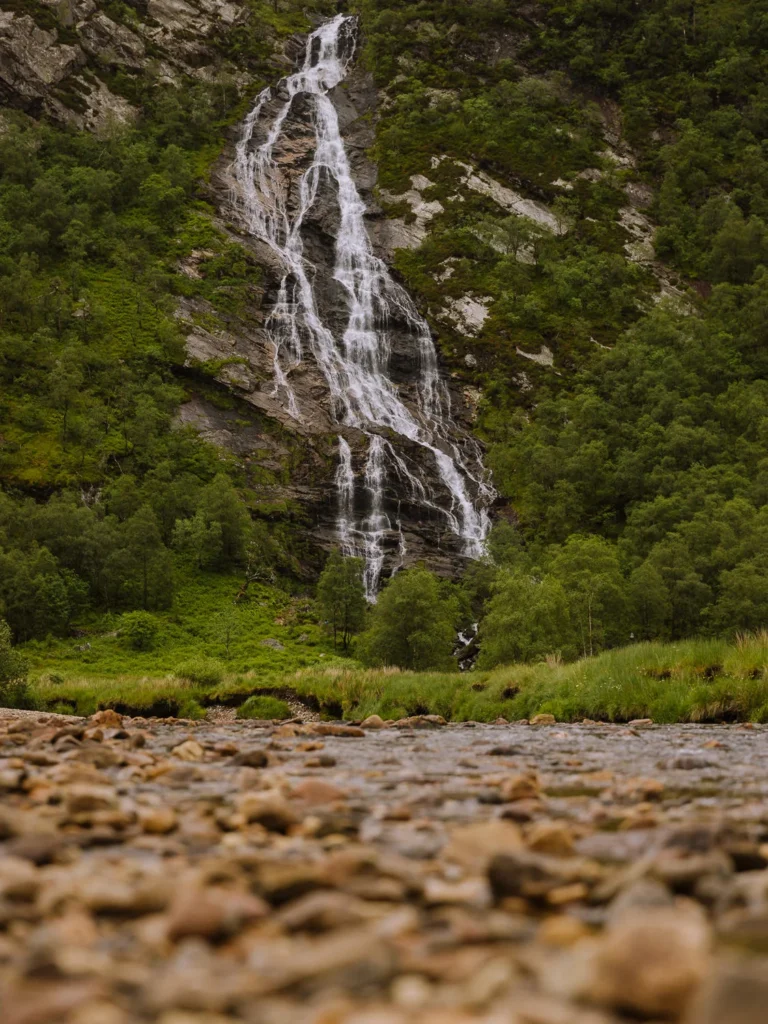
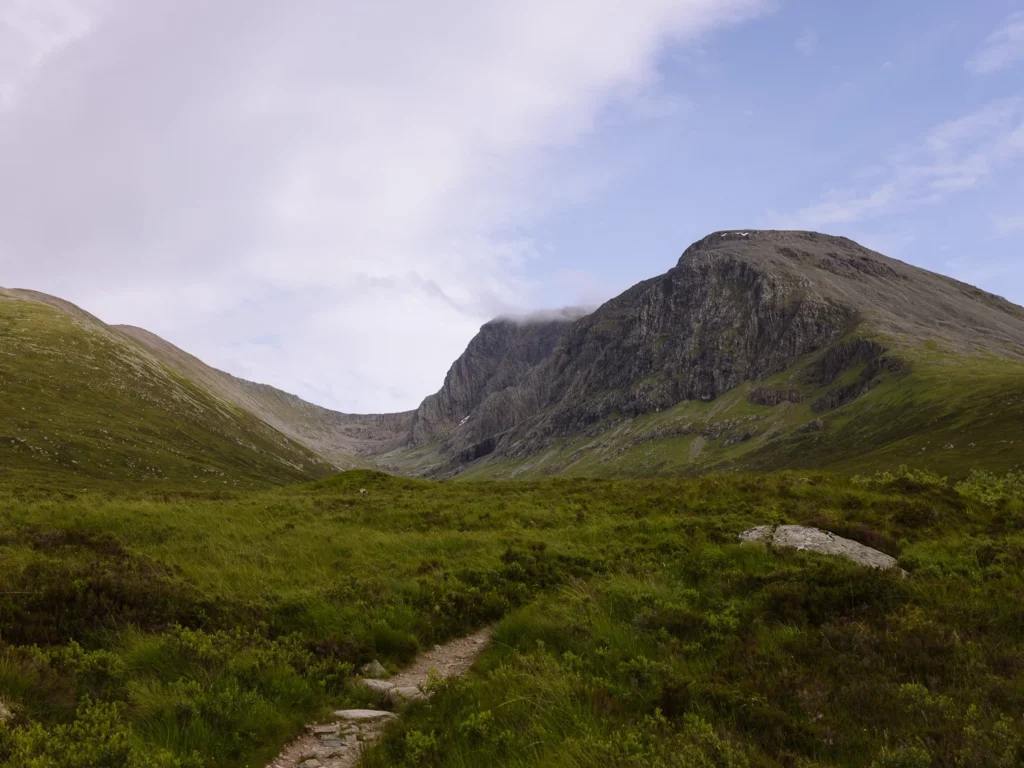
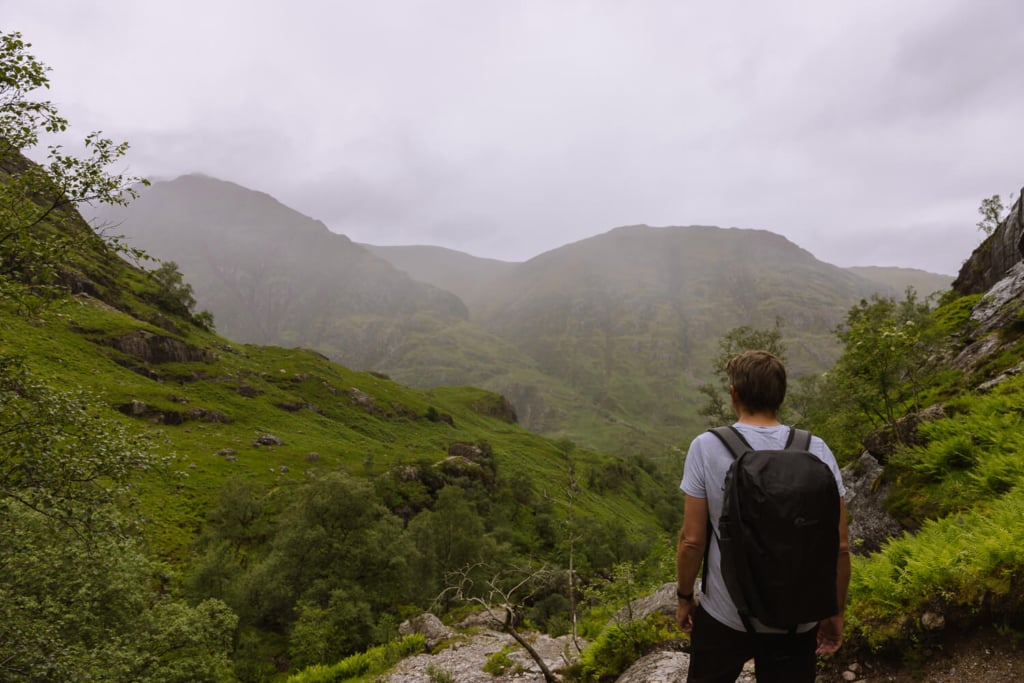
LUNCH
Depending on how long you spend in Inveraray, there are a few good options for lunch. The Kinghouse Climbers Bar serves a mix of traditional Scottish classics, such as haggis and Loch Leven mussels, as well as some pub favourites.
The Clachaig Inn is an old-fashioned hikers’ bar and restaurant. On cold, wet days, it serves as a warm and welcoming haven from the wind and rain. On sunny days, you can relax in the garden, gazing up at the mighty peaks.
AFTERNOON
If you have time and are up for a hike, try the Hidden Valley Walk from the Three Sisters Viewpoint (2-3 hours round trip). Or for an easy but pretty amble, take the 45-minute stroll around Glencoe Lochan. Details of both are on our Glencoe post.
Finally, leave Glencoe, head past Fort William and make your way to Loch Ness. Made famous by rather spurious claims of the Loch Ness Monster, the best place to stop along its shore is Urquhart Castle.
One of Scotland’s largest castles, it takes up a dramatic position above Loch Ness. The castle changed hands between the Scots and English numerous times, and its atmospheric ruins still offer a glimpse into its medieval past.
Unfortunately, it is not easy to get a good photo without paying the rather hefty entrance fee (£14). A better option is to take a 1-hour boat cruise on the loch. They run from Clansman Harbour and have good views over the loch and back to the castle.
STAY
This is where the itinerary ends. If you want somewhere special to spend that final night, try the Loch Ness Lodge. This elegantly appointed lodge is situated on a hill overlooking Loch Ness and is a fabulous way to conclude your road trip.

WHAT’S MISSING FROM THE ITINERARY?
We have tried to include all our favourite spots in the Scottish Highlands on this itinerary, but unfortunately, we had to exclude a couple of great places due to time constraints.
The Isle of Mull is a great destination. Tobermory is a pretty village with colourful houses and a great fish restaurant at the end of the pier; Duart Castle is an imposing medieval keep situated on a striking promontory; and Iona Abbey, perched just offshore, is a peaceful reminder of early Christianity.
But with no bridge to the island, and with the sights scattered across the isle, it takes a couple of days to do it justice.
Assynt is another area we have not covered. It is a land of wonderful and weird landscapes, but it is also remote, wild and rugged. The roads are often single-track, and getting around takes time. You can read more about the area in our Guide to Assynt.
If you have more time, consider adding one or both to your itinerary.
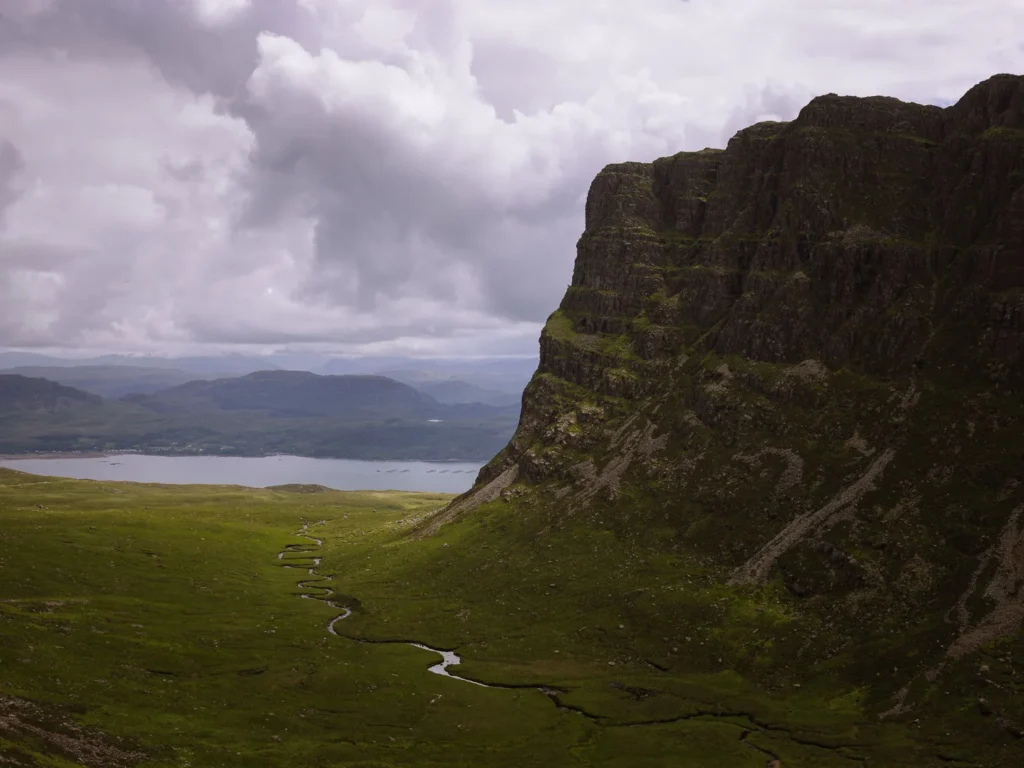
BEST TIME TO VISIT?
May and June are the best time to visit the Scottish Highlands. You have the most sunlight to enjoy all the scenic sights, the rainfall is at its lowest, and it’s not yet peak season.
July and August may potentially be slightly warmer, but the increase in visitor numbers means that accommodation will be booked out well in advance, and ferries and restaurants can also be very busy. Those midges can be annoying too.
September and October are also good months to visit. The days are getting shorter, but it is not yet cold. Visitor numbers are down, and most of the main attractions are still open.
Winter brings its own charms. Cold, short days, roaring log fires, and drams of whisky in old leather chairs offset the weather and shorter opening hours.
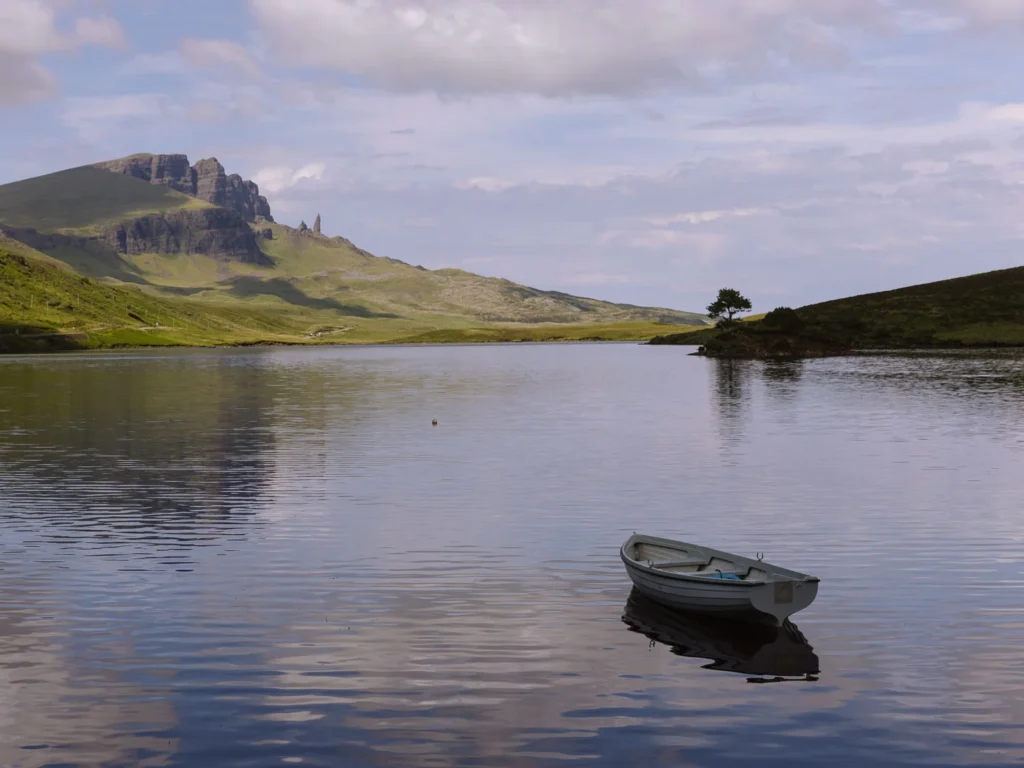
MORE SCOTLAND GUIDES
- Explore all our favourite places to visit in Scottish Highlands.
- Make sure you don’t miss any highlights in Glencoe.
- Find the best walking route through the Quiraing.
- Hike to the best viewpoints over the Old Man of Storr.
- Guide to all the best things to do on the Isle of Skye.
- Explore the under-visited landscapes of Assynt.
- Looking to explore more? Try our best places to visit in UK.

READER-SUPPORTED
When you buy through links on our site, we may earn a small affiliate commission at no extra cost to you.
Thanks for your support.
Paul & Mark.

